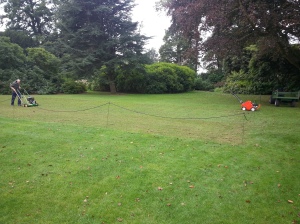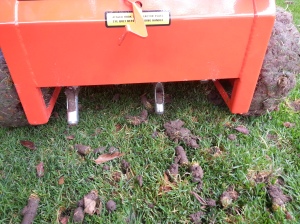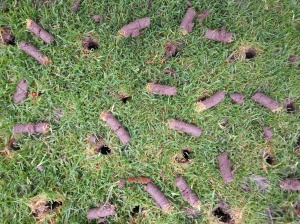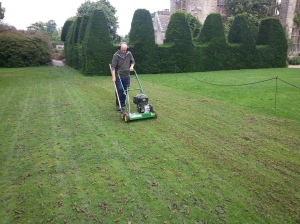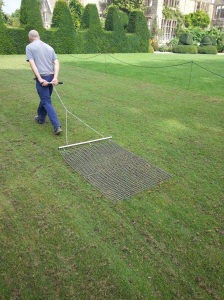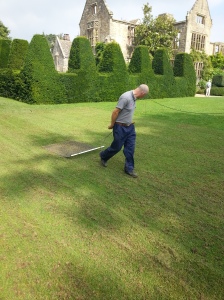The lawns at Nymans may not be the most celebrated part of these great gardens perhaps but there is certainly no danger of the garden team here taking them for granted in any way. A shabby lawn soon becomes very noticeable and can really detract from the overall effect of the planting displays and other garden features. A well-kept healthy lawn however can set off the beds and borders within and around the grassed areas perfectly. There are not many weeks of the year where we aren’t caring for our turf in one way or another but this time of season in particular is a very busy time when it comes to lawn management.
While the likes of mowing and edging will continue for some time yet until the late Autumn and early Winter temperatures start to cease grass growth, there are two practices which are dominating our turf time right now: namely aerating and scarifying the lawns. The traditional practice is to scarify first and then aerate (or spike) afterwards but this year we have switched things around a little. Once the area of grass in question has been freshly mown, we begin by spiking using the machine you can see in the picture above. This practice improves drainage and also allows better movement of air and water in the root zone by reducing compaction of the soil. A well-aerated lawn will also be able to cope and manage better in periods of drought or waterlogging. For a small domestic lawn, this aerating job can be done simply by pushing a garden fork into the lawn and wiggling it to create drainage holes.
As you can see from the above image, we are using a hollow-tine aerating machine which means that long tubes of soil (or plugs) are actually removed from the lawn instead of just a simple hole being made as would be done when using a solid-tine version. One option now would be to remove these soil plugs and compost them before brushing a top dressing material of a sandy loam mix into the vacant holes. This process can be a very time consuming and costly one however, especially if like us you have large sections of lawn that need caring for. It is also not necessary to perform this particular part of the lawn care regime every year, so this year here at Nymans we are trying something different. And that is where the next part of the work comes in…
Scarifying (which is essentially vigorous raking) helps to keep levels of thatch at an acceptable level. And what is this ‘thatch’, you may ask? Well, lawn thatch is determined as material such as old grass stems, dead moss and other debris that can build up, almost unnoticed, on top of the turf. Layers of thatch greater than 1cm deep can very quickly impede water and fertiliser penetration into the root zone. As well as hindering drainage, thatch can also encourage weeds and turf diseases to take hold so it is important give your grass a really good going over to remove as much as possible. It is worth noting that turf can be damaged if scarified too deeply however. This is especially important to remember if scarifying in Spring, as the lawn may not recover in the hot Summer conditions.
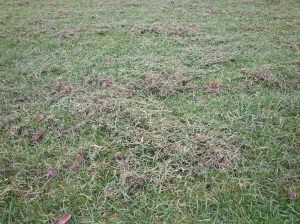
This is the sort of thatch material that we have been removing from the main lawn at Nymans this year
As I mentioned earlier, scarification is often done before the aerating but this year we have swapped the order because we have found that the process of using the scarifier actually breaks up the removed soil plugs at the same time as it removes the thatch. Therefore, instead of spending time sweeping up and removing the cores, we turn them into a kind of top dressing that can then be raked back into the holes. Before anyone asks why we would remove the soil from the lawns, only to add it back again, please let me explain. The plug that was removed is solid and compacted whereas the material that is left after the scarifier pass is lighter and crumblier and mixed in with the grass blades from the lawn surface making it ideal as a cheaper, easily created top dressing! All that remains to be done is to physically encourage the material back into the holes…
The remaining thatch and soil on the lawn is then removed with a large lawnmower and the process can be repeated on the next section of lawn. Once this process is complete we will also attempt to perk up any sections of tired lawn by giving them an Autumn feed which is high in phosphates and potash. This will help strong roots to develop over Winter, which will in turn produce healthy leaves and blades of grass next year. It is important not to be tempted to use a Spring fertiliser however as these contain high levels of nitrogen, which encourages soft, sappy leafy growth that’s vulnerable to disease and could be severely damaged by frost. As we head further in Autumn and beyond we will stop mowing altogether of course and simply make sure we remove fallen leaves from our lawns which could smother and weaken the grass, while also providing Winter shelter for unwelcome garden pests. It is also important to remember to avoid walking on your lawn when it’s frosty, as this can also damage the grass, leaving nasty black footprints for a while after.
So the next time you come and pay us a visit here at Nymans, try and look past the dazzling displays of flowers and foliage and maybe spare a thought for some of the hard work that goes into making our lawns look lovely too. Of course, there is plenty more to see and do here at all times of the year so to make sure you keep up to date with all that is going on at Nymans, don’t forget you can interact with us on both Twitter and Facebook as well as finding out all the important visitor information via our official website. If you want to be alerted by email when each new Nymans Garden Blog is published, simple click the ‘Follow’ button at the top of this page and carry out the instructions.

